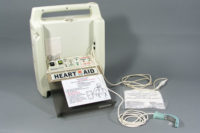I have worked extensively since the 1990s to help the AED industry and AED owners better design and operate AED programs. I helped found and was the first CEO of the company that created the National AED Registry. This experiential foundation gives me a deep appreciation for the problem of out-of-hospital SCA and why it remains so difficult to improve survival rates. In my view, AED registries are not, at least for now, a viable method to address this challenge. Here’s why.
Potential public health risks
In the last 15 years, public health awareness efforts have focused on the American Heart Association’s Chain of Survival, including early activation of 911 and the importance of bystander CPR and early defibrillation. There is a risk that promoting AED registries and mobile apps (effectively adding another link to the Chain of Survival) will confuse bystanders and cause delays in calling 911, beginning CPR and delivering early defibrillation. Plus, focusing on AED registries may detract from efforts to further expand AED deployment and encourage bystander CPR.
Unreliability of AED registry data
AED location and operational status information is supplied solely by people because AEDs are not capable of broadcasting location or status data electronically. Various AED registry websites encourage AED owners to register their devices and a number of crowdsourcing and gamification efforts have sought to gather this information.
There is no reliable way, however, to validate the accuracy of the data when first entered, and much of the data in registries is rarely updated. AEDs may move, be taken out of service or become inoperable — and these status changes often will not be reflected in registries.
More importantly, only a small fraction of the estimated 2.4 million public-access AEDs now deployed in the U.S. are “registered.”
And there are currently no cost-effective methods of delivering real-time indoor GPS-like functionality. Mobile apps tied to AED registries cannot deliver reliable directions to nearby AEDs. Thus, AED registry data cannot and should not be relied upon by 911 dispatch agencies or mobile app users involved in actual SCA emergencies..
AED registry system limitations
Several public and private AED registry systems now operate in the U.S. with more expected to come online. No single registry serves as the central repository for all AED location and status data, nor is a central repository feasible. Also, AED manufacturers and service providers maintain separate AED databases for a variety of purposes. No reliable, operationally efficient way to distribute aggregated AED data to 911 dispatch agencies or mobile apps for real-time use in SCA emergencies now exists.
The Food and Drug Administration (FDA) may mandate an AED registry. Whether primarily for epidemiological purposes or for 911 agency use, this approach is unlikely to work. FDA has no regulatory authority to force AED owners to register devices or to require local 911 dispatch agencies to consume AED registry data. In contrast to the national implantable cardioverter defibrillator (ICD) Registry, which ties hospital reimbursement to ICD registration, the federal government lacks equivalent economic leverage to force AED registration or AED data utilization. The better approach is for the FDA to refrain from considering an AED registry mandate until effective methods exist to capture and utilize AED location data.
911 dispatch agency fragmentation
Nearly 6,000 911 dispatch agencies exist in the U.S. Very few have developed systems and methods for integrating and utilizing AED location data in the SCA emergency call process. Few agencies view the ability to direct callers to nearby AEDs as an operational priority. Dispatch agencies electing to leverage AED location information must be able to accept data from multiple registries, each with its own proprietary data format and distribution methodology. Implementing such a complex system is a burdensome proposition that many will view as a poor use of public resources.
Legal liability constraints
The AED registry operating model theorizes bystanders will be directed to nearby AEDs either by 911 dispatchers or mobile apps. Even if AEDs are registered, this presumes that AED owners will allow their devices to be taken from the owner’s site to another location.
This is unlikely. AED owners are highly sensitive to liability risks. Their lawyers will legitimately resist allowing AEDs to be removed from the owner’s property. Current AED immunity laws offer often conflicting requirements and limited scopes of coverage. They really don’t encourage this broader AED operating model. Risks with this limitation can be mitigated using creative AED program design and risk management approaches. But absent significant changes in the litigation environment and existing AED laws, liability concerns will blunt widespread real-time use of AED registry data in SCA emergencies. With appropriate modifications, the proposed Cardiac Arrest Survival Act of 2013 (H.R. 2135) might help address legal liability constraints.
Meaningful short-term solutions
Limitations associated with AED registries remain daunting and will be barriers for
years to come. Meanwhile, energy and resources are better directed toward more effective approaches:
- Continue to promote AEDs and their benefits to the population at large, in public service announcements, etc., until we have achieved a level of awareness similar to that of fire extinguishers and the universal 911 emergency number;
- Design and operate comprehensive AED programs that ensure AED location awareness and appropriate SCA response;
- Develop cost-effective communications technologies that enable AEDs to broadcast their locations and status in real-time and a uniform data model for leveraging this data;
- Modernize AED immunity laws to reduce liability risks associated with AED use both at and outside an AED owner’s property.



